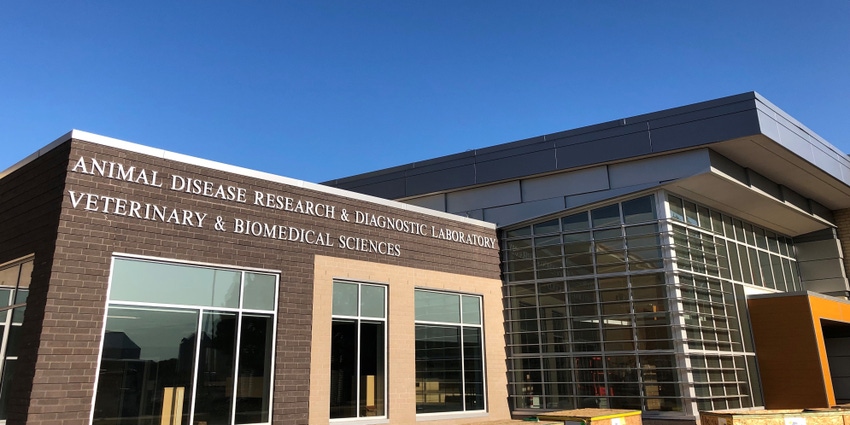New laboratory allows for better worker safety, biosecurity and biocontainment.
September 3, 2019

A ribbon-cutting ceremony for the new South Dakota Animal Disease Research & Diagnostic Laboratory (ADRDL) on the South Dakota State University (SDSU) campus in Brookings, S.D., will be held on Sept. 6.
The laboratory serves as the front line of defense in protecting South Dakota's $7.3 billion livestock industry against diseases and provides important diagnostic information for the state's wildlife and companion animals, according to an announcement from SDSU.
"The expansion and renovation of the Animal Disease Research & Diagnostic Laboratory is critical to animal health, public health and food safety,” South Dakota state veterinarian Dustin Oedekoven said. “This facility will protect the dedicated and talented people who work in the laboratory and will give them the tools to do the best work possible. Expert veterinary laboratory diagnostic and research capacity is important for the timely identification of emerging and zoonotic diseases and for the continuity of business when animal health events occur."
Dr. Jane Christopher-Hennings, head of the SDSU department of veterinary and biomedical sciences and director of the South Dakota ADRDL, noted the importance of the lab to the people of South Dakota and the country, explaining, “The ADRDL is a key component in protecting both human and animal health in South Dakota. The lab promotes animal health by detecting diseases and finding methods to control them as well as safeguarding human health by dealing with food safety issues and zoonotic diseases."
ADRDL is South Dakota’s only accredited, full-service, all-species veterinary diagnostic laboratory. ADRDL has a long history of serving the citizens of the state and region with timely and accurate veterinary diagnostic services, SDSU said.
It is the only veterinary diagnostic lab in the state accredited by the American Association of Veterinary Laboratory Diagnosticians. In addition, ADRDL is an integral member of the National Animal Health Laboratory Network, a network of diagnostic laboratories across the U.S. that help detect nationally significant animal diseases such as influenza, foot and mouth disease, African swine fever and other foreign animal diseases, the university said. Expertise in detecting agents of foodborne illness is important in ADRDL's role as a regional laboratory for the Food Emergency Response Network.
The laboratory also participates in the Food & Drug Administration's Genome “Trakr” Program for detection of pathogens in food and in the U.S. Department of Agriculture's Veterinary Laboratory Investigation Response Network to help FDA's Center for Veterinary Medicine investigate potential problems with regulated products such as animal feeds and animal pharmaceuticals.
According to SDSU, the renovation and expansion of ADRDL is important for continuing operations, since many of the mechanical systems of the old building needed to be replaced or updated to current standards (e.g., plumbing, heating, ventilation and electrical). A drive-up window for dropping off samples provides easy access to the lab, which is located in close proximity to the U.S. Highway 14 bypass. A Biosecurity Level-3 laboratory is included for isolation of infectious agents.
Christopher-Hennings said the lab has seen an increase in "same-day" testing of samples. The new lab allows for better worker safety, biosecurity and biocontainment. In the new building, staff and faculty will be able to perform additional diagnostics and research needed to help control animal health issues.
The building project was supported by commodity and farm organizations represented through South Dakota's Ag Unity, the state veterinarian, the South Dakota Animal Industry Board, the South Dakota Veterinary Medical Assn., legislative leaders and the governor's office to develop a funding package for the $58 million project.
The next step in the overall project will focus on completing renovations on the existing Veterinary & Biomedical Sciences/ADRDL building, which was built in 1967, with an addition in 1993. The renovation will allow for improvements in waterproofing, foundation and insulation, SDSU said. Work to renovate this building for teaching and research will commence following move-in to the new ADRDL. Roof replacement has already begun on the older building sections.
Source: South Dakota State University, which is solely responsible for the information provided and is wholly owned by the source. Informa Business Media and all its subsidiaries are not responsible for any of the content contained in this information asset.
You May Also Like


.png?width=300&auto=webp&quality=80&disable=upscale)
